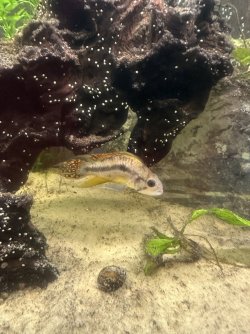Hi
We are trying to get a concrete answer for the sex of our last remaining appistogramma please. We acquired a pair of them when we purchased our previous tank. We were under the impression that this one was the female of the male/female pair. Unfortunately the other passed away last year, he was larger. We are looking to get her(?) a companion, but we wanted to be as sure as possible that she is female before introducing another. The colour levels vary at times and at some periods will spend a few days largely in a cave.
Many thanks in advance.


We are trying to get a concrete answer for the sex of our last remaining appistogramma please. We acquired a pair of them when we purchased our previous tank. We were under the impression that this one was the female of the male/female pair. Unfortunately the other passed away last year, he was larger. We are looking to get her(?) a companion, but we wanted to be as sure as possible that she is female before introducing another. The colour levels vary at times and at some periods will spend a few days largely in a cave.
Many thanks in advance.


